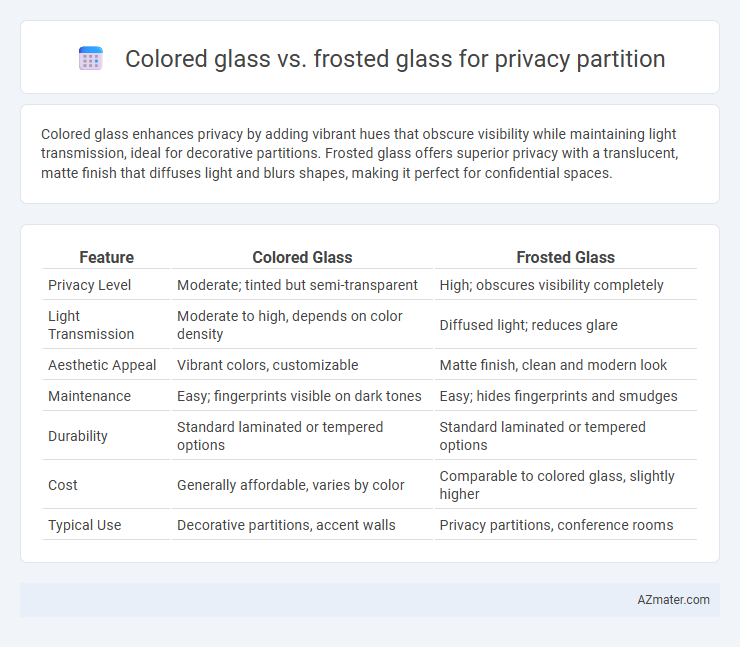Colored glass enhances privacy by adding vibrant hues that obscure visibility while maintaining light transmission, ideal for decorative partitions. Frosted glass offers superior privacy with a translucent, matte finish that diffuses light and blurs shapes, making it perfect for confidential spaces.
Table of Comparison
| Feature | Colored Glass | Frosted Glass |
|---|---|---|
| Privacy Level | Moderate; tinted but semi-transparent | High; obscures visibility completely |
| Light Transmission | Moderate to high, depends on color density | Diffused light; reduces glare |
| Aesthetic Appeal | Vibrant colors, customizable | Matte finish, clean and modern look |
| Maintenance | Easy; fingerprints visible on dark tones | Easy; hides fingerprints and smudges |
| Durability | Standard laminated or tempered options | Standard laminated or tempered options |
| Cost | Generally affordable, varies by color | Comparable to colored glass, slightly higher |
| Typical Use | Decorative partitions, accent walls | Privacy partitions, conference rooms |
Introduction to Privacy Glass Solutions
Colored glass enhances privacy partitions by incorporating tinted hues that reduce visibility while adding aesthetic appeal, making it ideal for modern office and residential spaces. Frosted glass achieves privacy through surface etching or sandblasting, diffusing light and obscuring visibility without sacrificing natural illumination. Both options provide effective privacy solutions, with colored glass emphasizing design customization and frosted glass prioritizing light diffusion and subtlety.
What is Colored Glass?
Colored glass is a type of glass that incorporates metallic oxides or other additives during production to create vibrant hues while maintaining transparency. It offers privacy by obscuring visibility without completely blocking light, making it ideal for partitions in offices or homes. Compared to frosted glass, colored glass provides aesthetic appeal with the added benefit of selective light transmission and partial concealment.
What is Frosted Glass?
Frosted glass is a type of glass that has been sandblasted or acid-etched to create a translucent, matte surface that diffuses light while obscuring visibility, making it ideal for privacy partitions. Unlike colored glass, which adds hue and aesthetic appeal, frosted glass enhances privacy without significantly impacting natural light transmission. This makes frosted glass a popular choice in office spaces, bathrooms, and conference rooms where both light and discretion are essential.
Privacy Levels: Colored vs Frosted Glass
Colored glass offers moderate privacy by tinting visibility while still allowing some light transmission, making it suitable for areas needing partial concealment without complete obscurity. Frosted glass provides a higher level of privacy by diffusing light and obscuring shapes and details, effectively preventing clear visual access. The choice between colored and frosted glass hinges on the desired balance between natural light and privacy requirements in a partition setting.
Aesthetic Appeal and Design Versatility
Colored glass enhances aesthetic appeal with vibrant hues that create dynamic, eye-catching privacy partitions suitable for modern and artistic interiors. Frosted glass offers subtle elegance through its translucent, matte finish, providing a neutral yet sophisticated design versatile for both minimalist and professional settings. Both materials provide privacy while allowing light diffusion, but colored glass adds a bold design statement, whereas frosted glass maintains understated refinement.
Light Transmission and Ambiance
Colored glass provides moderate light transmission, filtering natural light while introducing vibrant hues that enhance the ambiance with a decorative appeal. Frosted glass offers higher privacy by diffusing light evenly, creating a soft, muted glow that maintains brightness without compromising seclusion. Both materials balance privacy and illumination, but frosted glass excels in creating a calm, unobtrusive environment, whereas colored glass adds personality through its tinted light effects.
Maintenance and Cleaning Considerations
Colored glass for privacy partitions typically requires minimal maintenance, as it resists showing fingerprints and smudges due to its tinted surface, while frosted glass may reveal more dirt and water spots, necessitating regular cleaning to maintain its translucent appearance. Cleaning colored glass involves using non-abrasive glass cleaners that preserve the vibrancy of the color without scratching, whereas frosted glass demands gentle scrubbing with soft cloths or sponges to avoid damaging the etched or sandblasted texture. Both glass types benefit from routine cleaning schedules, but frosted glass may require more frequent attention to prevent buildup in its textured surface, affecting overall clarity and aesthetics.
Durability and Longevity Comparison
Colored glass features enhanced resistance to UV rays and scratches due to its pigmentation process, contributing to higher durability in privacy partitions. Frosted glass, while offering effective privacy through surface etching or sandblasting, can be more susceptible to surface wear and requires regular maintenance to preserve its appearance. Both types provide long-lasting solutions, but colored glass generally outperforms frosted glass in longevity and resistance to environmental damage.
Cost Analysis: Colored vs Frosted Glass
Colored glass generally incurs higher costs due to the complexity of adding pigments and maintaining consistent color quality, with prices averaging 20-30% more than standard frosted glass. Frosted glass, achieved through sandblasting or acid etching, offers a more budget-friendly option while still ensuring substantial privacy, typically costing between $15 to $50 per square foot. Both materials vary in price based on thickness, customization, and manufacturing process, but frosted glass remains the more economical choice for privacy partitions in commercial and residential settings.
Best Applications and Use Cases
Colored glass offers vibrant aesthetics and effective privacy for office partitions, conference rooms, and retail spaces requiring visual appeal alongside obstruction. Frosted glass excels in areas needing subtle privacy such as bathrooms, medical facilities, and corporate workstations by diffusing light while obscuring clear view. Both glass types enhance privacy but serve distinct design goals: colored glass emphasizes style and brand identity, while frosted glass prioritizes understated, uniform privacy.

Infographic: Colored glass vs Frosted glass for Privacy partition
 azmater.com
azmater.com